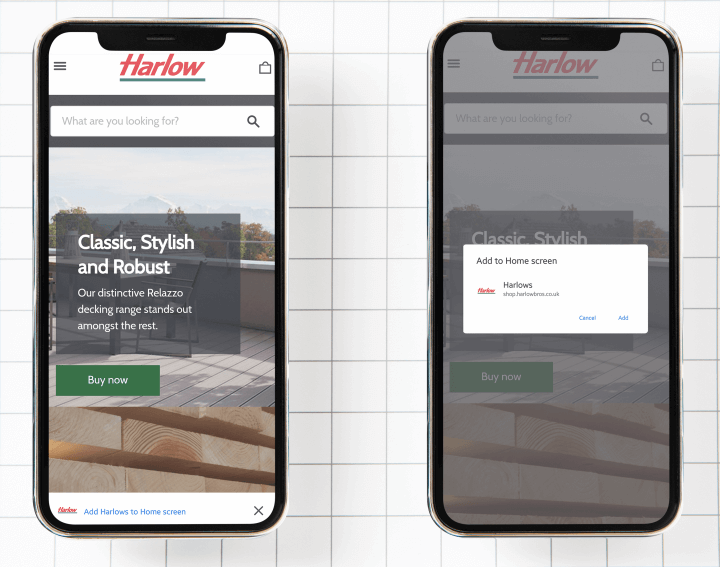10 Biggest Mobile Commerce Trends To Look Out For 2025

The shift to mobile is inevitable.
In fact, more than half of all internet traffic now comes from a mobile device and almost 62% of smartphone owners use a mobile device to shop, which means mobile is making its mark on the eCommerce world.
And if you don’t start catering to this new wave of shoppers, you could be missing out on tons of new customers–and potentially thousands of dollars in sales.
Mobile Commerce – also known as mCommerce, is a type of online selling. Instead of desktops or PCs, it takes place exclusively on mobiles. Therefore, mCommerce consumers have entirely different purchasing habits, expectations, and preferences.
Here are top 10 biggest Mobile Commerce trends to watch for in 2025- important developments that companies need to consider to ensure the growth of their online and in-store sales growth.
See more:
- eCommerce Trends 2025: How Can Businesses Adapt?
- 20+ Mobile App Design Trends In 2025 & Beyond
- Insights from Trending mCommerce Statistics for 2025
1. Mobile shopping apps
Mobile shopping apps are expected to be the primary way consumers shop online. The fact shows that 85% of consumers prefer mobile apps to mobile websites. Specifically, mobile apps convert 157% more than mobile web sessions. In 2024, $418.9 billion in mobile commerce sales came from smartphones, compared to $69.1 billion from tablets (Bussiness Insider).
Therefore, having a mobile app is becoming essential to stay competitive, as more businesses recognize the importance of targeting mobile users. Creating an app now puts a business on the fringe of the early adopter category.
>> See more: 26+ Features of Mobile Shop 2025 (Core To Advanced)
The shift to mobile shopping is here. Stay competitive and set your Shopify store apart with SimiCart’s easy-to-use Shopify Mobile App Builder. Start building your app now and join the early adopters making waves in mobile commerce!

2. AI-driven mobile commerce
AI and machine learning is transforming mobile commerce by introducing innovative solutions that redefine the shopping experience. One of the most significant trends is conversational AI, which enhances omnichannel interactions across platforms like SMS, chat, email, and phone. Early adopters of conversational AI are poised to gain a competitive edge, as it is expected to become a standard by 2025.
Another critical area of impact is customer service. AI-powered automation drastically reduces response and resolution times, leading to improved customer satisfaction. With capabilities to handle up to 70% of inquiries through chatbots and automated systems, businesses can scale support while minimizing costs. AI also allows for round-the-clock customer service, ensuring that customers’ needs are met promptly and efficiently.
AI also enhances mobile app functionality, driving smarter analytics and improved user experiences. Features like natural language processing (NLP) enable advanced search and voice interactions, while chatbot integration provides seamless support within apps. These advancements ensure that mobile apps remain intuitive, efficient, and aligned with customer expectations.

AI is one of the biggest mobile Commerce trends in 2025 and beyond
3. Social commerce
Social media should play a pivotal role in your mobile commerce strategy. It is getting even more influential and is now an important channel in regards to the actual churnover.
When you really get to it, Instagram is no longer just a place for cozy holiday photos anymore, as it is now a new sales platform that should be incorporated into your mobile Commerce strategy.
In fact, 31% of consumers use social media to browse for new products (more than deal websites or online magazines), and 74% consult social media to make a purchasing decision.
But, just posting a few photos to your Instagram is not enough. You need to take your mCommerce strategy further and take advantage of shoppable tags – a tool that allows brands to redirect their followers directly to their website from an Instagram post.

Shoppable tags are a great feature for brands to drive more sales since Instagram doesn’t allow links in captions.
You may ask yourself how to set Shoppable tags on your Instagram? Well, just simply follow these steps:
- Head to your Instagram Settings > double-checking you’re using a Business Profile.
- Agree to Facebook’s merchant agreement terms.
- Add a payment method to Facebook’s Business Manager.
- Connect your Product Catalog to your Business Manager.
- Wait for Facebook to approve your new account (this can take a few days).
- Turn on product tagging on Instagram when approved.
Then, you should be good to go!
4. Personalized Experiences
Personalization is rapidly becoming a cornerstone of mobile commerce trends, with both customers and businesses reaping significant benefits. Consumers now expect tailored interactions, with 76% anticipating personalized product recommendations and exclusive offers. The stakes are high, as 73% of shoppers are willing to switch brands if they don’t receive a consistent, omnichannel experience. Mobile shoppers particularly value user-friendly, secure, and personalized experiences that enhance their journey.
Businesses are increasingly relying on first-party and zero-party data collected directly from customers via surveys, quizzes, and other means. For example, beauty brand Jones Road uses a “find my shade” quiz to gather customer preferences, boosting average order value from $60 to $90 and achieving a 16% conversion rate. Such data builds rich customer profiles, enabling precise targeting that drives conversions and fosters loyalty.

5. Image search
Image search is a feature set to revolutionize the way customers search for products. A proper Image Search function, for example, recognizes object(s) in the captured picture and generates associated keywords to refine search results. With this, customers no longer need to search for products by specific keywords as now they simply need to snap a photo of the desired products, and have the intelligent algorithms take care of the rest.

For example, when customers search for a shirt, they will then be suggested tags that best describe the shirt. The whole process is easy, fast–and the search results are always accurate. What’s even more fascinating is that Image Search iseasier to implement than you may think. In fact, it doesn’t require extensive development and you can get a functional Image Search feature done in no time at all.
Read more: SimiCart’s New Image Search Feature: Harness the power of Artificial Intelligence (AI)
6. Voice shopping
Voice shopping is already here. According to reports, as much as 43% of users who own voice-enabled devices are using voice search to shop for products (Navar), and among smart speaker owners who regularly use them, 62% will make a purchase using voice technology in the next month. Voice assistants like Alexa make use of customers’ shopping history and allow them to voice-order with simple keywords such as coffee, laundry detergent, etc, making voice shopping an effortless experience for people.

7. Omnichannel Experiences
Today, consumers want seamless shopping experiences-regardless of where, how or why they’re shopping. Think about it: How many times do you browse products on your lunch break using your PC, then purchase the same product via your mobile phone when you get home?
Almost all (98%) Americans switch between devices on the same day, so I’ll bet your answer is “a lot”.
Your mCommerce strategy needs to be omnichannel – a fancy word for seamless across various channels. That could include mobile, social media, website or Google Ads.
Lucky for you, creating a seamless shopping experience isn’t as tricky as you think. Here’s how you can get started with this mobile commerce trend:
- Using consistent branding across all of your platforms.
- Allowing customers to create user profiles that can be used across all platforms: For example, displaying the same products someone’s added to their PC basket when logged in using a mobile phone.
- Personalizing content based on the content they’ve viewed elsewhere: For example, if someone’s viewed a product on their mobile phone, display similar products when they’re browsing via tablet.

(Consistent branding of Disney to improve their omni-channel marketing strategy)
If you browsed the mobile website, we bet you wouldn’t feel any different as you would if you were shopping online. No worries about privacy, no need to enter their information separately across various devices, and certainly no fear of a spammy replica website.
That’s the feeling you want to give your customers to boost engagement.
Companies with extremely strong omnichannel customer engagement retain 89% of their customer average traffic, compared to just 33% for companies with poor engagement.
8. NFC payments
As a part of the omnichannel experience, NFC (near-field communication) payment is a kind of contactless mobile payment that allows mobile phone owners to be able to complete in-store transactions in a fast and secure manner. NFC payments use the same kind of NFC chip found in credit cards and the like, but when people refer to NFC payments, all they really refer to is payments made with NFC-enabled smartphones.

NFC removes the complexity of payment, as with it, you only need a mobile phone to complete all kinds of transactions in a matter of seconds. There’s no more reaching for your wallets, and with NFC payments, you certainly won’t be finding yourself holding the line when trying to put the changes back in your wallet.
Furthermore, users can also scan NFC tags to get more information about a product. So in places like a museum or retail store, you will now start seeing products with NFC tags more frequently, as it’s basically a better version of QR/barcode scanning.

9. Augmented Reality Experiences
Augmented reality is a technique that marketers can use to display digital items on a screen with clever camera tricks. The name comes from an “augmented view” – something that’s not an exact match to real life, but uses elements to make it believable.
By 2020, AR will dominate the entire eCommerce market, with $120 billion expected to be generated by the end of the year.
AR performs better for mobile users than it would PC, desktop or tablet users. Why? Because augmented reality tends to be portable–devices need to be able to shift, move and adapt to get the full AR effect.

We doubt you’d get the full effect by tilting your desktop webcam to view the shoes.
This AR campaign also worked so well because people can see the product (almost) in the flesh before committing to a purchase. Considering 22% of shoppers return products because they look different than expected, it’s a great way to reduce your mCommerce return rates.
Read more: Ar – Augmented Reality: The Future of E-Commerce
10. Progressive Web App
Progressive web app is making their way into the mobile commerce trends, enabling more performance and app-like features for stores. What’s so special about this new technology is the fact that it is made to be installable and has all the essential features of a native app—and this means all the features like installability, push notifications, offline mode, etc are available in a PWA.

As PWA is inherently based on Web technologies, you can develop a PWA and have it work across every device that has a supporting browser. Consequently, this means that with a PWA, you no longer have to develop separate apps for different platforms, thus reducing development cost significantly. And with the right implementation, you can publish your PWA to app stores and customers can download your PWA just like how they would a native app.
Final Thoughts on Mobile Commerce Trends in 2025
Are you ready to refine your mCommerce strategy and see more conversions, sales, and customers in 2025? Remember to always think about user experience, and make sure your mobile strategy fits in with your omni-channel plans.
Hope you’ll find this article useful!

